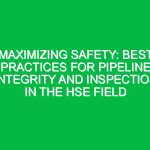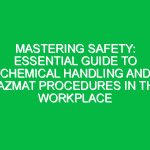In the realm of oil and gas operations, entering confined spaces is a task fraught with potential hazards. These spaces, often characterized by limited entry and exit points, can pose significant risks to workers due to the presence of hazardous substances, oxygen-deficient atmospheres, and the potential for fires or explosions. Given the high stakes, it’s crucial for companies in the Health Safety and Environment (HSE) domain to adopt comprehensive strategies to ensure the safety of their personnel. This article delves into essential strategies for maximizing safety during confined space entry in oil and gas operations, offering insights into best practices that can safeguard workers’ well-being.
Understanding Confined Spaces in Oil and Gas Operations
Before diving into safety strategies, it’s important to grasp what constitutes a confined space in the context of oil and gas operations. Typically, these are areas not designed for continuous occupancy, with limited or restricted means for entry or exit. Examples include tanks, vessels, silos, storage bins, hoppers, vaults, pits, manholes, tunnels, equipment housings, ductwork, and pipelines.
The Risks Associated with Confined Spaces
Confined spaces in oil and gas settings are fraught with hazards that can lead to accidents or fatalities. These include:
- Toxic Atmospheres: The accumulation of hazardous gases or vapors can poison workers or displace oxygen, leading to asphyxiation.
- Explosive Atmospheres: Certain gases or vapors can ignite, causing explosions or fires.
- Oxygen Deficiency or Enrichment: Too little or too much oxygen can be dangerous, leading to unconsciousness or increasing the risk of fire, respectively.
- Physical Hazards: Workers may face risks such as entrapment, engulfment, or being struck by falling objects.
Key Strategies for Safe Confined Space Entry
To mitigate these risks, adopting a series of strategic measures is essential. Here are the core strategies that should be part of any safety plan:
1. Conducting Thorough Risk Assessments
Before any confined space entry, a comprehensive risk assessment should be carried out. This involves identifying potential hazards, evaluating the risks associated with these hazards, and determining the necessary control measures to mitigate them. The risk assessment should be documented and reviewed regularly to ensure its relevance and effectiveness.
2. Implementing a Permit-to-Work System
A permit-to-work system is a formal written system used to control certain types of work that are potentially hazardous. It specifies the work to be done, the hazards involved, and the precautions to take. For confined space entry, this system ensures that all safety measures are in place before entry is allowed.
3. Ensuring Proper Ventilation
Proper ventilation is crucial to maintain a safe atmosphere within a confined space. It helps to remove or dilute toxic gases, vapors, or fumes and to supply fresh air. Depending on the situation, mechanical ventilation systems may be required to ensure adequate airflow.
4. Using Personal Protective Equipment (PPE)
Personal Protective Equipment (PPE) is essential for protecting workers from various hazards. Depending on the risk assessment, PPE may include respirators, gas detectors, protective clothing, helmets, gloves, and safety harnesses. It’s vital that workers are trained on the correct use and maintenance of their PPE.
5. Continuous Monitoring for Hazardous Atmospheres
Continuous monitoring of the atmosphere within a confined space is necessary to detect any changes that might pose a risk to workers. This includes monitoring for toxic gases, oxygen levels, and potential explosive atmospheres. Portable gas detectors are commonly used for this purpose.
6. Establishing Emergency and Rescue Procedures
Despite all precautions, emergencies can still occur. It’s essential to have a well-defined emergency and rescue plan in place, which includes procedures for evacuation, medical treatment, and rescue operations. Regular drills should be conducted to ensure that all team members are familiar with these procedures.
Training and Education: The Cornerstone of Safety
Comprehensive training and education are the cornerstones of a safe confined space entry program. Workers should be trained on the specific hazards associated with confined spaces, the use of PPE, emergency procedures, and the permit-to-work system. This training should be ongoing, with regular refreshers to ensure that safety remains at the forefront of workers’ minds.
Conclusion: Prioritizing Safety in Confined Spaces
Entering confined spaces in oil and gas operations requires meticulous planning, robust safety measures, and continuous vigilance. By conducting thorough risk assessments, implementing a permit-to-work system, ensuring proper ventilation, using appropriate PPE, continuously monitoring for hazardous atmospheres, and establishing emergency and rescue procedures, companies can significantly reduce the risks associated with confined space entry. Moreover, investing in comprehensive training and education programs is essential to empower workers with the knowledge and skills they need to stay safe. Ultimately, prioritizing safety not only protects workers but also enhances operational efficiency and preserves the integrity of oil and gas facilities.
Summary of Key Points
- Confined spaces in oil and gas operations pose significant risks, including toxic and explosive atmospheres, oxygen deficiency, and physical hazards.
- Conducting thorough risk assessments and implementing a permit-to-work system are critical first steps in ensuring safety.
- Proper ventilation, the use of PPE, and continuous atmospheric monitoring are essential to mitigate risks.
- Establishing emergency and rescue procedures and conducting regular drills are crucial for preparedness.
- Comprehensive training and education for workers are the cornerstones of a safe confined space entry program.
By adhering to these strategies, companies in the oil and gas sector can ensure the safety and well-being of their workers during confined space entry operations, thereby upholding the highest standards of health, safety, and environment (HSE) practices.


